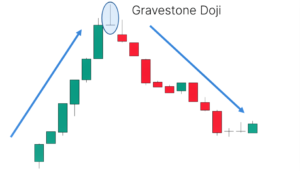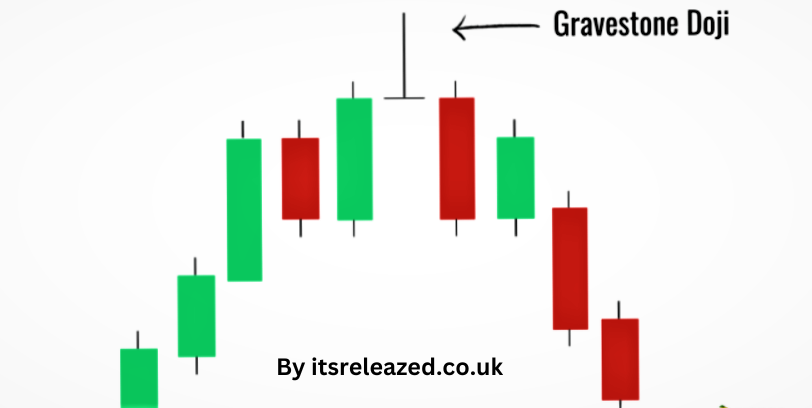Discover the gravestone doji, a powerful candlestick pattern that signals potential market reversals. Learn its formation and trading strategies.
Introduction
The gravestone doji is one of the most intriguing candlestick patterns in the realm of technical analysis. It provides invaluable insights into market sentiment and potential price reversals. Whether you are a seasoned trader or just beginning your journey, understanding this pattern can significantly enhance your trading strategies. Below, we delve deep into its formation, significance, and application to help you master this crucial aspect of technical analysis.
What is a Gravestone Doji?
The gravestone doji is a single candlestick pattern characterized by its unique shape. It forms when the opening, closing, and low prices are nearly identical, and the candlestick has a long upper wick. This formation resembles a gravestone, hence the name.
Key Characteristics of a Gravestone Doji:
- Long Upper Shadow: Indicates that the price was pushed significantly higher during the session but was unable to sustain those levels.
- No Lower Shadow: Represents minimal price movement below the opening and closing levels.
- Close Equals Open: The opening and closing prices are nearly identical, signifying indecision or rejection of higher prices.
How Does the Grave stone Doji Form?
The gravestone doji emerges in markets where buyers initially dominate, driving prices higher. However, by the session’s end, sellers regain control, pushing prices back to the opening level. This tug-of-war between buyers and sellers reflects uncertainty or a potential reversal in market direction.
Formation Conditions:
- Bullish Attempt: Buyers push the price upwards significantly.
- Sellers Take Over: Sellers enter the market aggressively, erasing the earlier gains.
- Closing Level: The price closes near or at the opening price, leaving a distinct long upper shadow.
Interpreting the Gravestone Doji
The grave stone doji is often interpreted as a bearish reversal signal, especially when it appears at the end of an uptrend. However, context matters, and its significance can vary based on the surrounding candlesticks and overall market conditions.
In an Uptrend:
- Indicates a potential reversal as buyers fail to maintain higher prices.
- Suggests increasing selling pressure.
In a Downtrend:
- May signal indecision or a continuation of the trend.
- Requires confirmation from subsequent candlesticks.
In Sideways Markets:
- Reflects market indecision and is less predictive.
How to Trade Using the Gravestone Doji
When trading based on the grave stone doji, it’s crucial to confirm its implications using additional technical indicators and patterns. Here’s a step-by-step approach:
- Identify the Pattern in Key Zones
- Look for the grave stone doji near resistance levels, trendlines, or Fibonacci retracement levels.
- Confirm with Volume
- High trading volume accompanying the pattern strengthens its significance.
- Use Additional Indicators
- Combine the grave stone doji with oscillators like RSI or MACD to validate overbought conditions or bearish momentum.
- Wait for Confirmation
- Observe subsequent candlesticks to confirm the reversal. For example, a bearish engulfing pattern following a grave stone doji enhances the reliability of the signal.
- Set Your Stop-Loss and Targets
- Place stop-loss orders slightly above the upper shadow to manage risk.
- Define profit targets based on nearby support levels or the overall trend.

Examples of Gravestone Doji in Real Markets
Case Study: Grave stone Doji in a Bull Market
In a prolonged uptrend, a gravestone doji forms near a key resistance level. The following day, a bearish candlestick confirms the reversal, leading to a significant price drop. Traders who identified the pattern and acted promptly secured substantial profits.
Case Study: Grave stone Doji in Consolidation
During a sideways market, the grave stone doji appears but fails to lead to a breakout. This highlights the importance of waiting for confirmation before taking action.
Gravestone Doji vs. Other Doji Patterns
Gravestone Doji vs. Dragonfly Doji
- Gravestone Doji: Long upper shadow, no lower shadow, bearish implications.
- Dragonfly Doji: Long lower shadow, no upper shadow, bullish implications.
Grave stone Doji vs. Standard Doji
- Grave stone Doji: Reflects rejection of higher prices, often bearish.
- Standard Doji: Indicates indecision, can be bullish or bearish depending on context.
Advantages of Using the Gravestone Doji in Trading
- Simplicity: Easy to identify due to its distinct shape.
- Relevance: Provides insights into market sentiment and potential reversals.
- Versatility: Applicable across various markets, including stocks, forex, and commodities.
Limitations of the Gravestone Doji
While the gravestone doji is a powerful tool, it has its limitations:
- False Signals: It may not always lead to a reversal, especially in strong trends.
- Context-Dependent: Requires confirmation and analysis of surrounding candlesticks.
- Subjectivity: Interpretation can vary among traders.
FAQs About Gravestone Doji
- What is a gravestone doji? A grave stone doji is a candlestick pattern that signals potential bearish reversal in the market. It forms when the price rises during the session but closes near the opening price, creating a long upper shadow and little or no lower shadow.
- How reliable is the grave stone doji pattern? The grave stone doji can be a reliable signal when used in conjunction with other indicators. However, like all candlestick patterns, it should not be used in isolation.
- Can gravestone doji be used for short-term trades? Yes, the grave stone doji can be used in both short-term and long-term trades, but traders should pay attention to the timeframe and confirmation of the signal.
- Is the grave stone doji pattern a guaranteed market reversal? No, the gravestone doji is not a guaranteed reversal pattern. It’s a potential indicator, but confirmation from other signals is necessary before acting on it.
- How can I combine the grave stone doji with other indicators? To increase the reliability of the grave stone doji, traders often combine it with moving averages, support/resistance levels, or volume indicators to confirm the potential reversal.
Conclusion
The gravestone doji is a vital candlestick pattern that can enhance your technical analysis arsenal. By understanding its formation, implications, and application, you can make more informed trading decisions. Remember, context and confirmation are key when leveraging this pattern.
For additional insights and strategies to elevate your trading game, explore other technical indicators and integrate them with the grave stone doji for optimal results.
